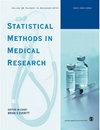单臂生物标记分层试验的等张设计
IF 1.6
3区 医学
Q3 HEALTH CARE SCIENCES & SERVICES
引用次数: 0
摘要
在根据基线生物标志物预先确定亚组的单臂试验中,通常假定生物标志物确定的亚组(即生物标志物阳性亚组)与其补充亚组(即生物标志物阴性亚组)相比,对治疗的反应相同或更高。我们的目标是确定治疗是对每个亚组有效,还是只对生物标志物阳性亚组有效,或者根本无效。针对这一问题,我们提出了等渗分层设计。该设计为生物标志物阳性和阴性受试者提供了一套联合决策规则,并利用生物标志物阴性和阳性亚组之间假定的反应单调性联合估计反应概率。与在每个生物标记物阳性和阴性子组中运行两个西蒙设计相比,新设计减少了对样本量的要求。例如,在我们考虑的情况下,新设计比运行两个西蒙设计所需的患者数量减少 23%-35%。另外,与只在生物标记物阳性亚组进行西蒙设计相比,新设计只需要多 40% 的患者就能评估生物标记物阴性和阳性亚组的反应概率。本文章由计算机程序翻译,如有差异,请以英文原文为准。
Isotonic design for single-arm biomarker stratified trials
In single-arm trials with a predefined subgroup based on baseline biomarkers, it is often assumed that a biomarker defined subgroup, the biomarker positive subgroup, has the same or higher response to treatment compared to its complement, the biomarker negative subgroup. The goal is to determine if the treatment is effective in each of the subgroups or in the biomarker positive subgroup only or not effective at all. We propose the isotonic stratified design for this problem. The design has a joint set of decision rules for biomarker positive and negative subjects and utilizes joint estimation of response probabilities using assumed monotonicity of response between the biomarker negative and positive subgroups. The new design reduces the sample size requirement when compared to running two Simon's designs in each biomarker positive and negative. For example, the new design requires 23%–35% fewer patients than running two Simon's designs for scenarios we considered. Alternatively, the new design allows evaluating the response probability in both biomarker negative and biomarker positive subgroups using only 40% more patients needed for running Simon's design in the biomarker positive subgroup only.
求助全文
通过发布文献求助,成功后即可免费获取论文全文。
去求助
来源期刊

Statistical Methods in Medical Research
医学-数学与计算生物学
CiteScore
4.10
自引率
4.30%
发文量
127
审稿时长
>12 weeks
期刊介绍:
Statistical Methods in Medical Research is a peer reviewed scholarly journal and is the leading vehicle for articles in all the main areas of medical statistics and an essential reference for all medical statisticians. This unique journal is devoted solely to statistics and medicine and aims to keep professionals abreast of the many powerful statistical techniques now available to the medical profession. This journal is a member of the Committee on Publication Ethics (COPE)
 求助内容:
求助内容: 应助结果提醒方式:
应助结果提醒方式:


